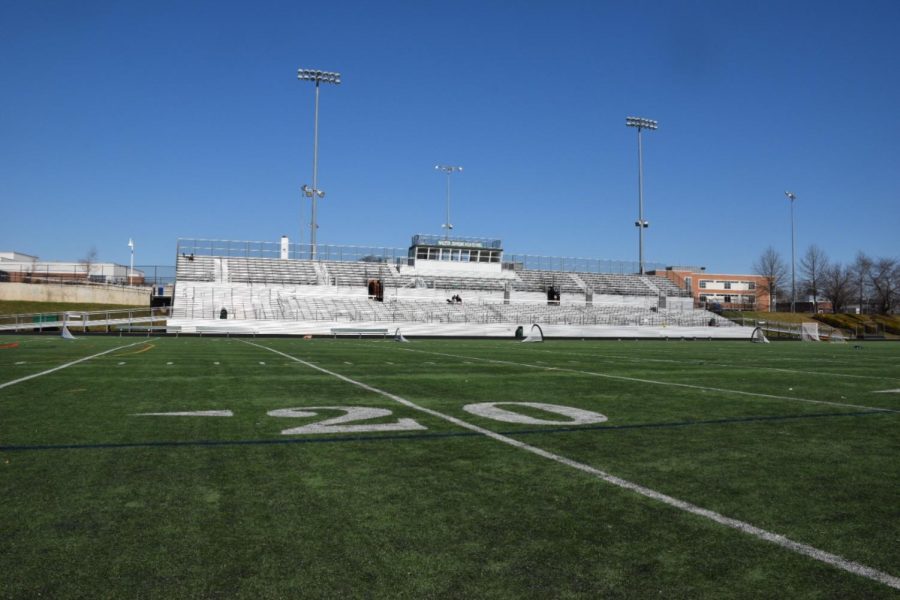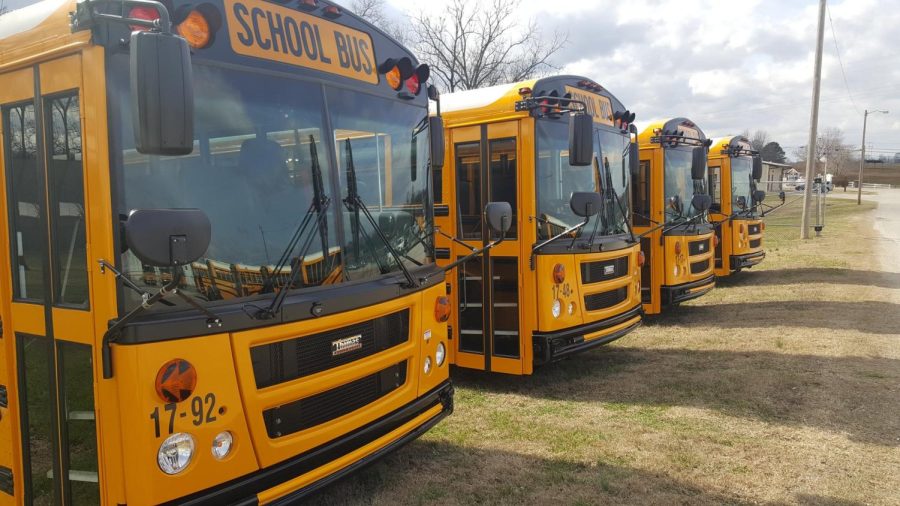Letter from FieldTurf VP Darren Gill, with Black & White response
March 22, 2018
Editor’s note: the March 19, 2018, B&W magazine ran an article headlined “Danger on our turf: is MCPS protecting athletes?” FieldTurf Vice President Darren Gill wrote the following Letter to the Editor in response to the article. The Black & White composed a response to Mr. Gill’s letter. The original article can be found online or in the print version of the magazine.
In light of your recent coverage of FieldTurf, I would like to clarify some points and defend the company’s record (“Danger on our turf: is MCPS protecting athletes?” 3/19/18). The bottom line is that FieldTurf has done right by its customers, and we will continue to do so. The facts tell the real story.
First, we are not aware as of today of a lawsuit filed against FieldTurf by Montgomery County. The County is not a party in the alleged class action lawsuit in New Jersey that your article mentions and to our knowledge has not done anything to become a party. The court in that lawsuit has not decided whether the case can go forward as a class action or whether the claims being asserted have any merit. FieldTurf strongly denies the claims.
Second, let’s look at the FieldTurf fields in Montgomery County, where we installed 10 fields with Duraspine. Of these 10, six have surpassed their warranty term, and the remaining four are within months of reaching that point. For example, Richard Montgomery is in its 10th season of play this year. And Walter Johnson will soon reach the 8-year mark. As for Montgomery Blair High School, their FieldTurf field was installed in 2009 and lasted for the full standard eight-year warranty term.
Third, let’s look at safety. The reality is that a peer-reviewed, scientific study found that FieldTurf fields are actually safer than natural grass fields when it comes to potential injury. This study was published in the well-respected American Journal of Sports Medicine. When it comes to field hardness, or GMAX, FieldTurf follows the industry standards, which are the levels set by ASTM International. All Montgomery County fields are tested twice per year and if parts of a field are tested and GMAX numbers are elevated, those areas are immediately remediated under warranty.
Fourth, consider the Duraspine issue. This relates to certain-color Duraspine fibers fading in high-UV environments, such as in Southern California. We have not sold Duraspine in years, and we have not seen one Duraspine-related issue in any of our fields in the greater D.C. area. In fact, all of the Duraspine fields that had been installed in the D.C. area have either surpassed, or are about to reach, the end of their eight-year warranty term. Worldwide, less than 3% of all FieldTurf have been replaced because of warranty claims associated with the Duraspine fiber. Also, keep in mind that the issues with Duraspine fibers have nothing to do with safety or field hardness, but only with how the field looks. And, as we’ve said many times, we are committed to honoring our warranties and working with our customers to address any issues if they arise.
The facts tell the real story: FieldTurf has delivered for its customers and will continue to stand by its products.
Darren Gill, Vice-President – Marketing, Innovation, Customer Service, FieldTurf
The Black & White responds:
Note: The Black & White attempted to contact Mr. Gill for comment prior to the publication of our article. Mr. Gill did not respond to our request.
There are several misleading claims in Mr. Gill’s letter.
To Mr. Gill’s first point: In his claim that Montgomery County has not joined the lawsuit, Mr. Gill may have confused Montgomery County Public Schools, Montgomery County Parks and Montgomery County in general. They are not the same. As noted in the article, Montgomery County Public Schools, which owns the WJ and RM fields, has not yet joined the lawsuit. MCPS spokesman Derek Turner was cited in the story saying that MCPS was evaluating the situation and would join the lawsuit if necessary. However, the article correctly states that Montgomery Parks, which owns the Blair field, has joined the lawsuit.
To Mr. Gill’s second point: The Black & White can only comment on the three fields mentioned in our article—WJ, RM and Blair. These are the Duraspine fields installed at MCPS schools and were the focus of our piece. All three have failed safety tests prior to the conclusion of their warranty term and one has been replaced prematurely, as noted in the article. There are several other Duraspine fields within the geographic municipality of Montgomery County that we did not address because they are not at MCPS schools.
To Mr. Gill’s third point: Mr. Gill’s letter also states that “FieldTurf fields are actually safer than natural grass fields when it comes to potential injury,” citing a 2016 study by Dr. Michael Meyers. However, the study Mr. Gill is referring to was based solely on collegiate soccer players. Indeed, Meyers directly states that “the findings of this study, however, may not be generalizable to other levels of competition or to other artificial surfaces.”
It’s also important to note that Dr. Meyers’ research was partially funded by FieldTurf and sought to prove a hypothesis of equal safety. In addition, a 2012 study published in the American Journal of Sports Medicine found that common injuries like knee and ankle sprains in the NFL were 22 percent more common on FieldTurf fields than natural grass. There are numerous conflicting studies related to the safety of artificial turf in general, and FieldTurf specifically.
However, this argument in Mr. Gill’s letter is irrelevant, as our article was concerned specifically with Duraspine fields (which FieldTurf no longer sells), not all FieldTurf fields in general.
To Mr. Gill’s fourth point: FieldTurf continues to maintain that Duraspine only affects how a field looks in certain high-UV environments (as noted in our article). Of the organizations from 46 states and D.C. that have joined the class-action suit, most are not based in high-UV environments. As further noted in our piece, the class-action suit also alleges Duraspine fields wear out faster than FieldTurf promised—in addition to the aesthetic concerns.
Mr. Gill also claims that less than three percent of Duraspine fields world-wide have required replacing due to issues with the fibers. While this may be true, NJ Advance Media reports that “FieldTurf concedes that nearly one of every five Duraspine fields in the U.S. has been replaced because of premature deterioration.” NJ Advance also notes that the number of affected fields is likely even higher because customers were not informed of the issues with Duraspine and how to diagnose them.
We feel we made these points clear in our initial article and stand by our reporting.
—Tiger Bjӧrnlund, Sam Shiffman
Managing Editors
—Lily Friedman, Carmen Molina
Online and Print Editors-in-Chief








Bailey Condrey • Oct 22, 2018 at 2:17 pm
Dear Black and White journalists and editors,
Your investigative journalism has added important historical perspective to the discussion of the MCPS, Field Turf, synthetic turf relationship. The facts also reveal that the most significant issue with the Duraspine synthetic turf carpet was plastic grass blade weakening and ultimate failure resulting in them breaking from the carpet backing by the millions. An ST field fails when the grass blades can no longer hold the infill in place creating dangerous hard spots throughout the pitch. Darren Gill knows the issues with Duraspine have never been aesthetic or Field Turf wouldn’t have sued the Duraspine producers.
The failure of the Walter Johnson ST field was documented more than two years ago by local activists and news outlets. However, MCPS has failed to show leadership on this issue by joining the Class Action suit. One has to ask why MCPS does not seek to recover taxpayer funds from the fraudulent sale of this product to our public school system?
Perhaps the Black and White staff already works on this aspect of the story.
Kathy Michels • Oct 17, 2018 at 6:03 pm
Kudos to the Black and White editors and staff for one of the clearest, factual no-nonsense take downs of FieldTurf’s “alternative facts” I have yet seen. Unfortunately, these days it is unusual to see such thoughtful, incisive reporting and response in the mainstream press. You all give me hope. The future of the free press and responsible relevant journalism is in good hands.
I urge you to stay on top of this topic and in particular what’s going on in Washington DC where early adoption of these plastic sports surfaces has led to buyers remorse. MCPS and the rest of MoCo should learn from the problems with cost waste , heat and hardness and not head down the same path. Investigative reporting is essential to linking lived experience with planning.
Thank you!
Carol Falk • Oct 11, 2018 at 1:50 pm
Bravo to Whitman HS reporters and editors! Excellent, thoroughly researched work and nice followup to Darren Gill’s assertions.
Nathan Geesing • Mar 22, 2018 at 2:02 pm
lmao, Darren Gill, Vice-President – Marketing, Innovation, Customer Service, FieldTurf got absolutely bodied